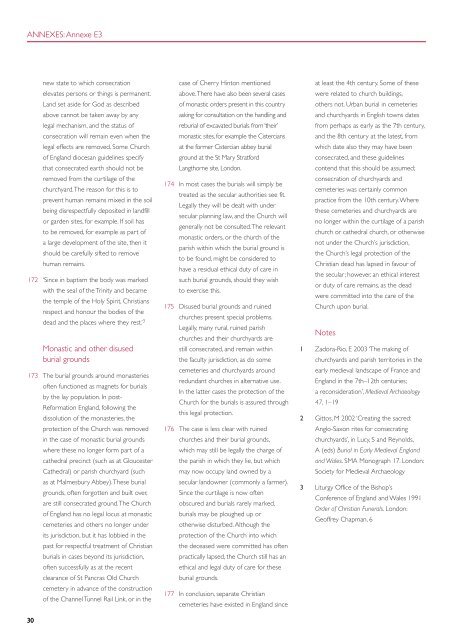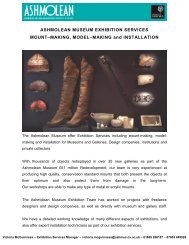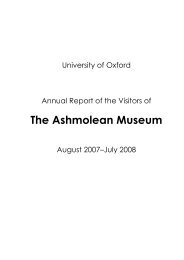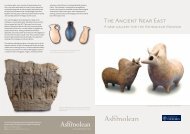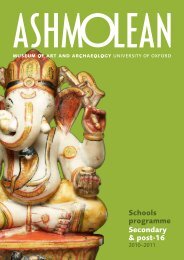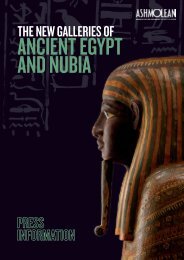English Heritage and the Church of England Guidance for best ...
English Heritage and the Church of England Guidance for best ...
English Heritage and the Church of England Guidance for best ...
You also want an ePaper? Increase the reach of your titles
YUMPU automatically turns print PDFs into web optimized ePapers that Google loves.
ANNEXES: Annexe E3<br />
new state to which consecration<br />
elevates persons or things is permanent.<br />
L<strong>and</strong> set aside <strong>for</strong> God as described<br />
above cannot be taken away by any<br />
legal mechanism, <strong>and</strong> <strong>the</strong> status <strong>of</strong><br />
consecration will remain even when <strong>the</strong><br />
legal effects are removed. Some <strong>Church</strong><br />
<strong>of</strong> Engl<strong>and</strong> diocesan guidelines specify<br />
that consecrated earth should not be<br />
removed from <strong>the</strong> curtilage <strong>of</strong> <strong>the</strong><br />
churchyard.The reason <strong>for</strong> this is to<br />
prevent human remains mixed in <strong>the</strong> soil<br />
being disrespectfully deposited in l<strong>and</strong>fill<br />
or garden sites, <strong>for</strong> example. If soil has<br />
to be removed, <strong>for</strong> example as part <strong>of</strong><br />
a large development <strong>of</strong> <strong>the</strong> site, <strong>the</strong>n it<br />
should be carefully sifted to remove<br />
human remains.<br />
172 ‘Since in baptism <strong>the</strong> body was marked<br />
with <strong>the</strong> seal <strong>of</strong> <strong>the</strong> Trinity <strong>and</strong> became<br />
<strong>the</strong> temple <strong>of</strong> <strong>the</strong> Holy Spirit, Christians<br />
respect <strong>and</strong> honour <strong>the</strong> bodies <strong>of</strong> <strong>the</strong><br />
dead <strong>and</strong> <strong>the</strong> places where <strong>the</strong>y rest.’ 3<br />
Monastic <strong>and</strong> o<strong>the</strong>r disused<br />
burial grounds<br />
173 The burial grounds around monasteries<br />
<strong>of</strong>ten functioned as magnets <strong>for</strong> burials<br />
by <strong>the</strong> lay population. In post-<br />
Re<strong>for</strong>mation Engl<strong>and</strong>, following <strong>the</strong><br />
dissolution <strong>of</strong> <strong>the</strong> monasteries, <strong>the</strong><br />
protection <strong>of</strong> <strong>the</strong> <strong>Church</strong> was removed<br />
in <strong>the</strong> case <strong>of</strong> monastic burial grounds<br />
where <strong>the</strong>se no longer <strong>for</strong>m part <strong>of</strong> a<br />
ca<strong>the</strong>dral precinct (such as at Gloucester<br />
Ca<strong>the</strong>dral) or parish churchyard (such<br />
as at Malmesbury Abbey).These burial<br />
grounds, <strong>of</strong>ten <strong>for</strong>gotten <strong>and</strong> built over,<br />
are still consecrated ground.The <strong>Church</strong><br />
<strong>of</strong> Engl<strong>and</strong> has no legal locus at monastic<br />
cemeteries <strong>and</strong> o<strong>the</strong>rs no longer under<br />
its jurisdiction, but it has lobbied in <strong>the</strong><br />
past <strong>for</strong> respectful treatment <strong>of</strong> Christian<br />
burials in cases beyond its jurisdiction,<br />
<strong>of</strong>ten successfully as at <strong>the</strong> recent<br />
clearance <strong>of</strong> St Pancras Old <strong>Church</strong><br />
cemetery in advance <strong>of</strong> <strong>the</strong> construction<br />
<strong>of</strong> <strong>the</strong> Channel Tunnel Rail Link, or in <strong>the</strong><br />
30<br />
case <strong>of</strong> Cherry Hinton mentioned<br />
above.There have also been several cases<br />
<strong>of</strong> monastic orders present in this country<br />
asking <strong>for</strong> consultation on <strong>the</strong> h<strong>and</strong>ling <strong>and</strong><br />
reburial <strong>of</strong> excavated burials from ‘<strong>the</strong>ir’<br />
monastic sites, <strong>for</strong> example <strong>the</strong> Cistercians<br />
at <strong>the</strong> <strong>for</strong>mer Cistercian abbey burial<br />
ground at <strong>the</strong> St Mary Strat<strong>for</strong>d<br />
Langthorne site, London.<br />
174 In most cases <strong>the</strong> burials will simply be<br />
treated as <strong>the</strong> secular authorities see fit.<br />
Legally <strong>the</strong>y will be dealt with under<br />
secular planning law, <strong>and</strong> <strong>the</strong> <strong>Church</strong> will<br />
generally not be consulted.The relevant<br />
monastic orders, or <strong>the</strong> church <strong>of</strong> <strong>the</strong><br />
parish within which <strong>the</strong> burial ground is<br />
to be found, might be considered to<br />
have a residual ethical duty <strong>of</strong> care in<br />
such burial grounds, should <strong>the</strong>y wish<br />
to exercise this.<br />
175 Disused burial grounds <strong>and</strong> ruined<br />
churches present special problems.<br />
Legally, many rural, ruined parish<br />
churches <strong>and</strong> <strong>the</strong>ir churchyards are<br />
still consecrated, <strong>and</strong> remain within 1<br />
<strong>the</strong> faculty jurisdiction, as do some<br />
cemeteries <strong>and</strong> churchyards around<br />
redundant churches in alternative use.<br />
In <strong>the</strong> latter cases <strong>the</strong> protection <strong>of</strong> <strong>the</strong><br />
<strong>Church</strong> <strong>for</strong> <strong>the</strong> burials is assured through<br />
this legal protection.<br />
2<br />
176 The case is less clear with ruined<br />
churches <strong>and</strong> <strong>the</strong>ir burial grounds,<br />
which may still be legally <strong>the</strong> charge <strong>of</strong><br />
<strong>the</strong> parish in which <strong>the</strong>y lie, but which<br />
may now occupy l<strong>and</strong> owned by a<br />
secular l<strong>and</strong>owner (commonly a farmer).<br />
3<br />
Since <strong>the</strong> curtilage is now <strong>of</strong>ten<br />
obscured <strong>and</strong> burials rarely marked,<br />
burials may be ploughed up or<br />
o<strong>the</strong>rwise disturbed. Although <strong>the</strong><br />
protection <strong>of</strong> <strong>the</strong> <strong>Church</strong> into which<br />
<strong>the</strong> deceased were committed has <strong>of</strong>ten<br />
practically lapsed, <strong>the</strong> <strong>Church</strong> still has an<br />
ethical <strong>and</strong> legal duty <strong>of</strong> care <strong>for</strong> <strong>the</strong>se<br />
burial grounds.<br />
177 In conclusion, separate Christian<br />
cemeteries have existed in Engl<strong>and</strong> since<br />
at least <strong>the</strong> 4th century. Some <strong>of</strong> <strong>the</strong>se<br />
were related to church buildings,<br />
o<strong>the</strong>rs not. Urban burial in cemeteries<br />
<strong>and</strong> churchyards in <strong>English</strong> towns dates<br />
from perhaps as early as <strong>the</strong> 7th century,<br />
<strong>and</strong> <strong>the</strong> 8th century at <strong>the</strong> latest, from<br />
which date also <strong>the</strong>y may have been<br />
consecrated, <strong>and</strong> <strong>the</strong>se guidelines<br />
contend that this should be assumed;<br />
consecration <strong>of</strong> churchyards <strong>and</strong><br />
cemeteries was certainly common<br />
practice from <strong>the</strong> 10th century.Where<br />
<strong>the</strong>se cemeteries <strong>and</strong> churchyards are<br />
no longer within <strong>the</strong> curtilage <strong>of</strong> a parish<br />
church or ca<strong>the</strong>dral church, or o<strong>the</strong>rwise<br />
not under <strong>the</strong> <strong>Church</strong>’s jurisdiction,<br />
<strong>the</strong> <strong>Church</strong>’s legal protection <strong>of</strong> <strong>the</strong><br />
Christian dead has lapsed in favour <strong>of</strong><br />
<strong>the</strong> secular; however, an ethical interest<br />
or duty <strong>of</strong> care remains, as <strong>the</strong> dead<br />
were committed into <strong>the</strong> care <strong>of</strong> <strong>the</strong><br />
<strong>Church</strong> upon burial.<br />
Notes<br />
Zadora-Rio, E 2003 ‘The making <strong>of</strong><br />
churchyards <strong>and</strong> parish territories in <strong>the</strong><br />
early medieval l<strong>and</strong>scape <strong>of</strong> France <strong>and</strong><br />
Engl<strong>and</strong> in <strong>the</strong> 7th–12th centuries;<br />
a reconsideration’, Medieval Archaeology<br />
47, 1–19<br />
Gittos, M 2002 ‘Creating <strong>the</strong> sacred:<br />
Anglo-Saxon rites <strong>for</strong> consecrating<br />
churchyards’, in Lucy, S <strong>and</strong> Reynolds,<br />
A (eds) Burial in Early Medieval Engl<strong>and</strong><br />
<strong>and</strong> Wales. SMA Monograph 17. London:<br />
Society <strong>for</strong> Medieval Archaeology<br />
Liturgy Office <strong>of</strong> <strong>the</strong> Bishop’s<br />
Conference <strong>of</strong> Engl<strong>and</strong> <strong>and</strong> Wales 1991<br />
Order <strong>of</strong> Christian Funerals. London:<br />
Ge<strong>of</strong>frey Chapman, 6


